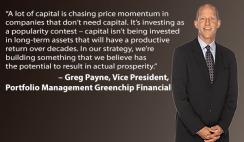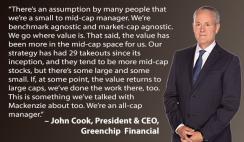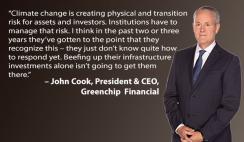You could say Greenchip Financial founders John Cook and Greg Payne were satisfied with their early days in the investment industry, but not overly impressed by what they witnessed. Undoubtedly, they both believed, there was something better and more appealing out there. It was the first tech bubble and its “prodigious waste of capital, the euphoria, the crazy valuations, and the answer to the inevitable crash being low interest rates and encouraging massive allocations of capital to arguably inefficient suburban expansion and real estate speculation” that left Payne disillusioned. He exited the investment world to pursue a Ph.D. in economics – uncertain if he would return.
For Cook, the epiphany had come a few years prior, and he ditched a traditional investment career with a big-name asset manager to lead development of a large non-profit tech incubator in Toronto. “When I finished at MaRS, I was looking for a business that was unrelated to investment management and that I could help grow,” says Cook. “And I was looking particularly at Canada and thinking about all the opportunities that would arise from the massive energy shift that would have to transpire for global sustainability.”
In 2007, Payne concluded that in order to stave off the worst effects of climate change and other environmental challenges, a massive global shift was necessary from fossil fuels to renewable energy, liquid fuels to electrons, and inefficient processes to efficient ones. About $2.5 trillion of new capital investment each year by 2030 would be required to finance the transition, Payne calculated. “I could reconcile a return to investing for an opportunity to influence the direction of capital to somewhere it really needed to go,” he says.
Cook and Payne met when they both joined an environmental private equity firm. They quickly determined they couldn’t raise enough money in the venture space to seriously address sustainability challenges to the extent they wanted – a realization that launched Greenchip in 2007. More recently, a relationship with Mackenzie Investments grew into a full partnership in 2018 with the launch of a strategy managed by Greenchip. Today, the strategy they oversee is pure, specialized and focused on a small subset of companies selling environmental products. It’s the farthest possible thing from greenwashing, and because of how they select companies, the strategy is ideal for diversification via a growing niche segment of the market.
II recently spoke with Cook and Payne about their approach to investing, how they’ve developed a keen sense for spotting value in the companies the strategy invests in, the state of play in sustainable investing today, and knowing when to steer clear of the hype.
What’s the difference between your strategy and what we’ll call a “basic” ESG investing strategy which might just look at companies’ ESG scores?
John Cook: We look at the revenues of businesses, and specifically whether those revenues are driven by selling environmentally superior products and services. We have a universe of 700 to 800 businesses. If you want exposure to the drivers of environmental challenges or opportunities, then you need environmental thematic investing because investing in banks and healthcare companies and FANGs that have nice ESG scores doesn’t give you that. When a lot of institutional investors think about environmental investing, they think of their private equity portfolios filled with, for example, clean tech infrastructure at one end of the risk continuum – say, a renewable utilities project – and at the other end of the scale basic ESG type equities strategies. What they have generally missed are opportunities in listed solutions providers in the middle.
Greg Payne: Companies like the FANGs that beef up their ESG scores are some of the biggest corporate consumers of renewable energy. Our approach is a very specific and positively focused investment strategy that benefits when corporate management and ownership push companies in the direction of general ESG improvement, and in doing so make decisions to buy products and services from the types of companies that we invest in.

Given your history and track record, do you still hear some investors say they worry about sacrificing returns in the name of sustainability?
Payne: We heard it a lot at the beginning, and I’d say we’re still in the middle of the risk continuum John just mentioned. But we do have a track record for more than 10 years where we don’t believe returns have been sacrificed, and lately environmental companies and indexes, and our peers, have been getting increased attention. Year after year increases in electric mobility, and the dominance of renewable energy relative to other forms of electricity are also getting people’s attention. So, we don’t hear the question about sacrificed returns very often anymore.
Greg, it has been more than 10 years since you made the $2.5 trillion calculation – where are we at in terms of getting there? And since you first made that calculation, have the goalposts moved farther out?
Payne: We’re at about $800 billion in new capital being invested each year, and that $2.5 trillion was calculated for 2030. On the other hand, $1 of investment in wind and solar today will get you what $5 or $10 would have in 2007 when that calculation was first made. At the time, we thought there would be a good cost curve decline, but for solar and wind that curve has gone faster and further than we could’ve imagined back then. And we are constantly seeing further advances – cost curves on batteries, for example, or in the use of bio materials as an alternative to petrochemicals. In short, the evolution of cost efficiency leaves room for optimism.
In the context of your investment philosophy and strategy, has the pandemic revealed anything new or reinforced any your existing thoughts?
Cook: That capital still isn’t going to the right places, that in general the world and investors don’t think sufficiently long term or manage risks particularly well.
That said, what should asset owners be investing in that they currently are not?
Payne: Infrastructure, transportation, clean water production and distribution, and the way we use energy in food and water production. In the developing world there has been a lot of investment in infrastructure, but globally there’s less going into capex and more that’s being recycled by the financial markets through stock buybacks, shareholder returns, and money-losing companies in consumer services or consumer tech. A lot of capital is chasing price momentum in companies that don’t need capital. It’s investing as a popularity contest – capital isn’t being invested in long-term assets that will have a productive return over decades. In our strategy, we’re building something that we believe has the potential to result in actual prosperity.
Cook: Here’s how it plays out in the renewable energy space when capital is just looking for rent off its money rather than actually growing profit streams: Renewable power producers globally are sort of like utilities, spinning off dependable cash-flow streams. When we first researched the sector, they looked to us like they fit into two buckets – those playing a high-yield game targeted at investors and offering a healthy dividend, and others that did not pay dividends. It was very clear that the market was pricing these buckets differently. The bucket with the dividend payers was getting a much higher price in the market. But the yield that CEOs and management were spinning out forced them to go back to the market and raise very expensive money to fund their growth. At Greenchip, we were finding companies that didn’t have to do that, and which were able to take the free cash they had and develop more renewable energy – and that’s what we and our investors really wanted. In the end, the game of going back to the market and raising expensive money and then issuing higher dividends ended up causing some of those businesses to fail. The focus for us is on businesses taking the capital they have and investing it to increase future cash flows, and that has really worked well for us in the long term. Boralex, a renewable developer we’ve held since inception, is a great example of this strategy. But you need to attract investors that share that long-term perspective.

How did you develop that sense of value and avoiding the hype around some companies?
Cook: We’re pretty sensitive to hype masters, and every sector has them.
Payne: Despite a maxim that’s often repeated in our world, the market sometimes gets it drastically wrong. AOL Time Warner was a great example. When the experts or smartest guys in the room do something, there’s a tendency for everyone to get get caught up in mass euphoria or mass revulsion. But it’s at those times that thinking for yourself can be an opportunity if you’re confident in the way you’ve thought things through and understand the risks. Since we started the strategy, by all broad metrics value has had a very difficult time of it and momentum has been the only way to play. Sticking to our guns has paid off, however.
When we started the firm, the hype was all about solar, and First Solar garnered most of the headlines. It had thin film technology that used cadmium telluride instead of the typical silicon-based panels that were prevalent. First Solar had a cost advantage at the time because polysilicon was in short supply. The whole industry was installing about three gigawatts of solar per year, and solar cost nearly $10 per watt. First Solar had a market value of about $30 billion at the time, and there were a few other companies – all U.S. and European – enjoying lofty valuations. The market was tremendously excited and saw that solar had a cost curve in front of it. In fact, the market underestimated cost declines just like I said we did. Today solar now installs well over 100 gigawatts per year, so that’s thirtyfold growth over slightly more than 10 years.
The market was right about all of that, but it was wrong in assuming that Western companies, with high costs and high margins, and a lot of government subsidies, would last forever and that there wouldn’t be competition, or a shift in market shares and margin. And that’s exactly what happened. Commodity tech is typically the domain of giant Asian manufacturers, and this was no different. In fact, the market is now 80% plus supplied by Chinese production. First Solar is still there, but its market cap is about $5 billion dollars, not $30 billion.
And what was Greenchip’s position while all of that played out?
Payne: We stayed out of solar at that time, and if we hadn’t we wouldn’t be here talking to you today. Finding the value opportunities has a positive side, but it also helps you avoid the disasters. The renewable energy space at large dropped by more than 80% between 2008 and 2012 – in other words, it flipped from euphoria revulsion when investors who’d lost their shirt didn’t want anything to do with solar. We heard every excuse – “It’s a commodity,” and “The Chinese are just going to beat each other up,” and “They’re never going to make any money at it,” and “It’s subsidized, it’s not a real business.”
We’ve been invested in solar since about 2012. Our largest positions have been the dominant Chinese players that really clobbered the Western companies and each other, as well. There were multiple tiers of Chinese companies, and a lot of low-quality, low-price competition. We saw that was beginning to change, that the top 10 were increasing market share, and that global brand and scale were becoming a barrier to entry. Further, these companies were evolving to provide products to the world at a verifiable quality, good price, and increasingly without subsidy. The cost of solar energy was becoming competitive with other forms of electricity. And we saw companies that were dirt cheap by any metric that we could find. We’ve been in those companies to varying degrees since 2012, and they are the companies that have contributed the most to our performance over the history of the strategy. Investing in those companies separated us from our peers while some other environmental thematic shops closed down. Among the few of us who remain still, none played solar like we did.

What has been overhyped of late?
Payne: Plant-based proteins. Hydrogen has been going on forever, but it’s really in full steam today.
Cook: I’m going to generalize and say our space for the last decade has not been about getting in front of a particular innovation. It’s been about finding the value. It’s one of the few spaces where value has genuinely worked, and could, in fact, keep you in business.
What are the benefits of Greenchip’s partnership with Mackenzie Investments?
Cook: We’ve had a relationship with Mackenzie Investments since we started Greenchip, but about five years ago it became clear to me that Mackenzie had an understanding that the great energy transition was a megatrend, so there was a macroeconomic case to support this space. Then Mackenzie launched two specific SRI strategies – a women’s leadership strategy and an ESG balanced strategy – and we could see where we would fit in. Regarding the cultural change around how capital needs to get to our space, Mackenzie always seemed very open to us defining the differences between an environmental theme and ESG. They understood the thesis that we were trying to invest around and saw the long-term growth potential. In addition, it’s a global opportunity, and as we continue to build out our team I’d rather focus on investment expertise and Mackenzie has the capability of distributing it around the world institutionally.
Speaking of global, let’s talk a bit more about the companies in your strategy.
Payne: The basic criteria for inclusion in an environmental thematic strategy is the question of what they do, not how they behave. That’s the distinction between ESG and thematic. Beyond that, we are fairly inclusive, and for that we mean a small company – up to $100 million in revenue – that’s just getting started should be a pure play. Between $100 million and a $1 billion, we want it to be at least half dedicated to our sectors. Over $1 billion in revenue, we slide that down to 20%.
Cook: We’re currently overweight industrials, utilities, materials, and we’re very underweight financials, healthcare, and consumer discretionary. From an industry standpoint, those 700 to 800 businesses represent a very small subset of the global market.
Payne: Very different than the global market, but even very different from what we see from our peers, which are typically invested in larger companies and more invested in U.S. businesses. The U.S. has the highest valuations, bar none, by a wide degree of magnitude. We do have American companies, but we’ve been dramatically underweight in the highest performing market for the full duration of our strategy. Compared to our peers, we take a lot of positions it doesn’t seem like anybody else is taking.
Cook: There’s an assumption by many people that we’re a small to mid-cap manager. We’re benchmark agnostic and market-cap agnostic. We go where value is. That said, the value has been more in the mid-cap space for us. Our strategy has had 29 takeouts since its inception, and they tend to be more mid-cap stocks, but there’s some large and some small. If, at some point, the value returns to large caps, we’ve done the work there, too. This is something we’ve talked with Mackenzie about too. We’re an all-cap manager.
Payne: Certainly, those takeouts speak to the recognition of value. They have been major value uplifts for investors, and have been in the sort of peripheral derivative sectors to some of the hot trends, such as in electric mobility today.

Your firm takes a long-term view, and so do many in the II audience. It begs the question – how do you think the future might unfold in your space?
Payne: Given what we’ve seen happen this year, I’d say we’ll all need more humility in the future. That said, our perspective hasn’t changed much from 10 years ago. We still see the financial industry and global economies at large mis-allocating capital, although our space has grown. We don’t think that can last another 10 years. We think there are tremendous fissures and pressure points developing because, eventually, this multi-decade trend that we’re talking about will end. And that could have profound implications, not just for the kind of things that we invest in, but for societies at large. We do think that blue-chip portfolios and the capital-light industries that make up the vast majority of the overall market value that’s in publicly traded markets today are very much at risk from the kind of driving forces that we’re talking about – climate change, environmental change, resource scarcity, or demographic pressures – or a combination of those forces.
Cook: Climate change is creating physical and transition risk for assets and investors. Institutions have to manage that risk. I think in the past two or three years they’ve gotten to the point that they recognize this – they just don’t know quite how to respond yet. Beefing up their infrastructure investments alone isn’t going to get them there. They are going to have to reinvest in some of the businesses that make the manufacturing equipment and infrastructure necessary to build a more sustainable economy. As I said, I think CEOs understand these risks, but there’s a disconnect when you get down to people whose day-to-day job is all about what they did last quarter and how they are going to do in the next two or three quarters. That’s why, in our case, there’s not necessarily a natural bucket for what we do right now, which is why there’s so few of us doing it. But I’m quite confident that more and more investors are realizing the need for that bucket.
This material is for marketing and informational purposes only and does not constitute an offer of investment products or services (or an invitation to make such offer). This material, including examples related to specific securities, is not intended to constitute investment advice or any form of recommendation.






